Types and Purpose of Organisations
VerifiedAdded on 2023/01/06
|13
|3890
|50
AI Summary
This document provides an overview of different types of organisations and their purposes. It explains the relationship between organisational functions and objectives. It also identifies the positive and negative impact of the macro environment on business operations. The document focuses on TESCO as a case study.
Contribute Materials
Your contribution can guide someone’s learning journey. Share your
documents today.
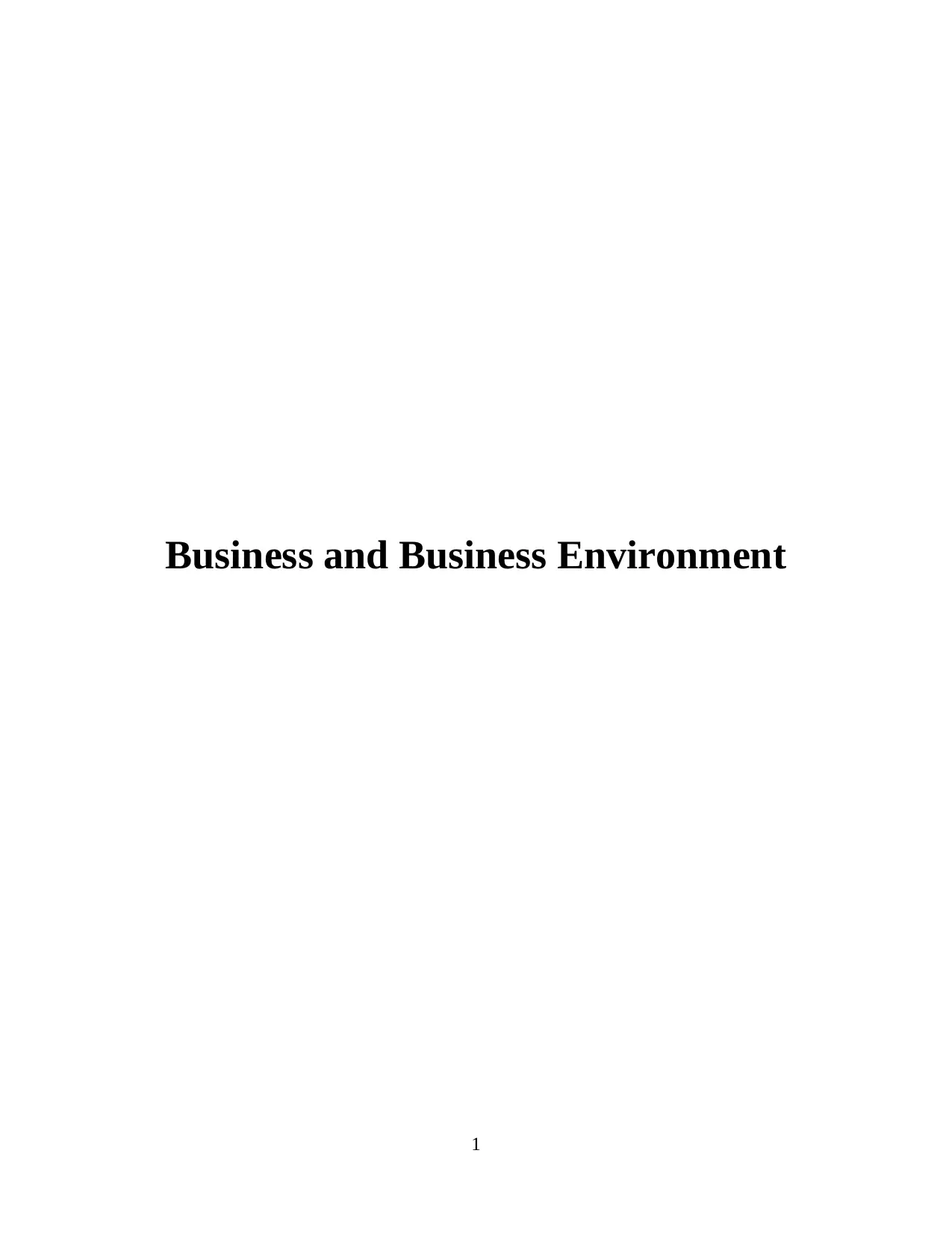
Business and Business Environment
1
1
Secure Best Marks with AI Grader
Need help grading? Try our AI Grader for instant feedback on your assignments.
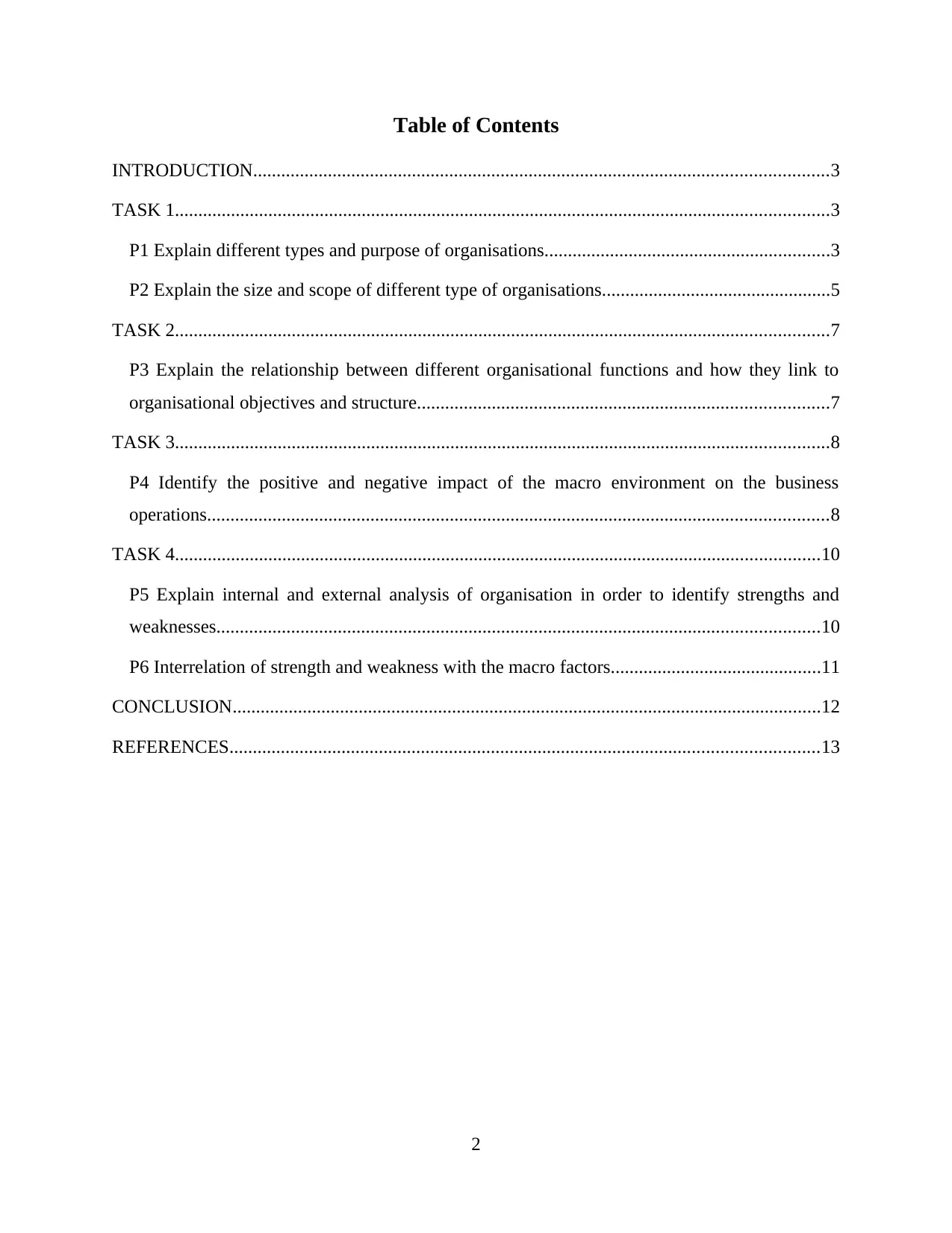
Table of Contents
INTRODUCTION...........................................................................................................................3
TASK 1............................................................................................................................................3
P1 Explain different types and purpose of organisations.............................................................3
P2 Explain the size and scope of different type of organisations.................................................5
TASK 2............................................................................................................................................7
P3 Explain the relationship between different organisational functions and how they link to
organisational objectives and structure........................................................................................7
TASK 3............................................................................................................................................8
P4 Identify the positive and negative impact of the macro environment on the business
operations.....................................................................................................................................8
TASK 4..........................................................................................................................................10
P5 Explain internal and external analysis of organisation in order to identify strengths and
weaknesses.................................................................................................................................10
P6 Interrelation of strength and weakness with the macro factors.............................................11
CONCLUSION..............................................................................................................................12
REFERENCES..............................................................................................................................13
2
INTRODUCTION...........................................................................................................................3
TASK 1............................................................................................................................................3
P1 Explain different types and purpose of organisations.............................................................3
P2 Explain the size and scope of different type of organisations.................................................5
TASK 2............................................................................................................................................7
P3 Explain the relationship between different organisational functions and how they link to
organisational objectives and structure........................................................................................7
TASK 3............................................................................................................................................8
P4 Identify the positive and negative impact of the macro environment on the business
operations.....................................................................................................................................8
TASK 4..........................................................................................................................................10
P5 Explain internal and external analysis of organisation in order to identify strengths and
weaknesses.................................................................................................................................10
P6 Interrelation of strength and weakness with the macro factors.............................................11
CONCLUSION..............................................................................................................................12
REFERENCES..............................................................................................................................13
2
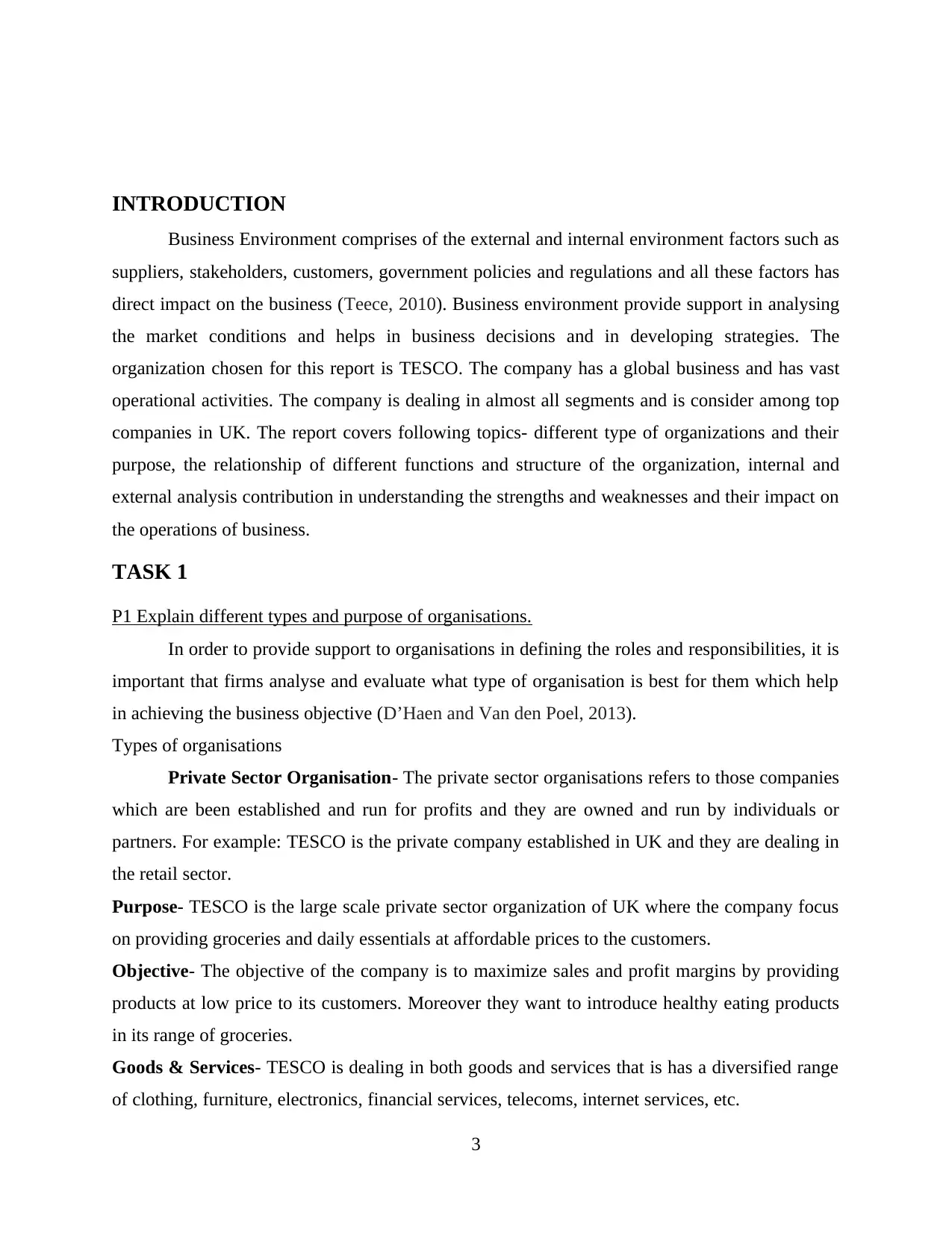
INTRODUCTION
Business Environment comprises of the external and internal environment factors such as
suppliers, stakeholders, customers, government policies and regulations and all these factors has
direct impact on the business (Teece, 2010). Business environment provide support in analysing
the market conditions and helps in business decisions and in developing strategies. The
organization chosen for this report is TESCO. The company has a global business and has vast
operational activities. The company is dealing in almost all segments and is consider among top
companies in UK. The report covers following topics- different type of organizations and their
purpose, the relationship of different functions and structure of the organization, internal and
external analysis contribution in understanding the strengths and weaknesses and their impact on
the operations of business.
TASK 1
P1 Explain different types and purpose of organisations.
In order to provide support to organisations in defining the roles and responsibilities, it is
important that firms analyse and evaluate what type of organisation is best for them which help
in achieving the business objective (D’Haen and Van den Poel, 2013).
Types of organisations
Private Sector Organisation- The private sector organisations refers to those companies
which are been established and run for profits and they are owned and run by individuals or
partners. For example: TESCO is the private company established in UK and they are dealing in
the retail sector.
Purpose- TESCO is the large scale private sector organization of UK where the company focus
on providing groceries and daily essentials at affordable prices to the customers.
Objective- The objective of the company is to maximize sales and profit margins by providing
products at low price to its customers. Moreover they want to introduce healthy eating products
in its range of groceries.
Goods & Services- TESCO is dealing in both goods and services that is has a diversified range
of clothing, furniture, electronics, financial services, telecoms, internet services, etc.
3
Business Environment comprises of the external and internal environment factors such as
suppliers, stakeholders, customers, government policies and regulations and all these factors has
direct impact on the business (Teece, 2010). Business environment provide support in analysing
the market conditions and helps in business decisions and in developing strategies. The
organization chosen for this report is TESCO. The company has a global business and has vast
operational activities. The company is dealing in almost all segments and is consider among top
companies in UK. The report covers following topics- different type of organizations and their
purpose, the relationship of different functions and structure of the organization, internal and
external analysis contribution in understanding the strengths and weaknesses and their impact on
the operations of business.
TASK 1
P1 Explain different types and purpose of organisations.
In order to provide support to organisations in defining the roles and responsibilities, it is
important that firms analyse and evaluate what type of organisation is best for them which help
in achieving the business objective (D’Haen and Van den Poel, 2013).
Types of organisations
Private Sector Organisation- The private sector organisations refers to those companies
which are been established and run for profits and they are owned and run by individuals or
partners. For example: TESCO is the private company established in UK and they are dealing in
the retail sector.
Purpose- TESCO is the large scale private sector organization of UK where the company focus
on providing groceries and daily essentials at affordable prices to the customers.
Objective- The objective of the company is to maximize sales and profit margins by providing
products at low price to its customers. Moreover they want to introduce healthy eating products
in its range of groceries.
Goods & Services- TESCO is dealing in both goods and services that is has a diversified range
of clothing, furniture, electronics, financial services, telecoms, internet services, etc.
3

Type of Private sector organisations:
Sole trader: Sole trader is very simple from of business where business is operated and
run by individuals.
Partnership: This is a type of private organisation which is run by two or more people
that is under legal agreement two or more individuals establishes their business.
Limited liability partnership: These are those companies which are limited to perform
operations to the extent of investment.
Limited company: A limited company is a type of private sector organisation which
operates as a separate legal entity.
Legal structure- In the context of TESCO, it is a limited company which is owned and run by
investors and shareholders. The company is following flat hierarchical structure in order to
establish good communication among all departments (Herbst and Merz, 2011).
Public Sector Organisation- These are those type of organisations which operate for
serving society and are owned by government and agencies. Their main focus is providing
benefit to society and not to earn profits. For example: NHS(National Health Services) is a
company operated and owned by government and they provide healthcare services to people for
no charge.
Purpose- NHS (National Health Services) is operating with the funds provided by welfare
department of UK. The primary focus of the company is to provide good healthcare facilities and
services to the people, specially to those who cannot afford expansive treatments.
Objective- The objective of the organisation is to keep people healthy and focus is on reduction
of health inequalities from country.
Products and Services- The organisation deal in service sector that is in GPs and dentists to
hospitals and in case of emergency.
Type of public sector organisations
Departmental undertakings: These are the oldest form of public sector organisation
which are established and run by ministry.
Statutory corporations: These are those type of public sector organisations which
are finance by government (central or state) and are mention in the special act of
parliament.
4
Sole trader: Sole trader is very simple from of business where business is operated and
run by individuals.
Partnership: This is a type of private organisation which is run by two or more people
that is under legal agreement two or more individuals establishes their business.
Limited liability partnership: These are those companies which are limited to perform
operations to the extent of investment.
Limited company: A limited company is a type of private sector organisation which
operates as a separate legal entity.
Legal structure- In the context of TESCO, it is a limited company which is owned and run by
investors and shareholders. The company is following flat hierarchical structure in order to
establish good communication among all departments (Herbst and Merz, 2011).
Public Sector Organisation- These are those type of organisations which operate for
serving society and are owned by government and agencies. Their main focus is providing
benefit to society and not to earn profits. For example: NHS(National Health Services) is a
company operated and owned by government and they provide healthcare services to people for
no charge.
Purpose- NHS (National Health Services) is operating with the funds provided by welfare
department of UK. The primary focus of the company is to provide good healthcare facilities and
services to the people, specially to those who cannot afford expansive treatments.
Objective- The objective of the organisation is to keep people healthy and focus is on reduction
of health inequalities from country.
Products and Services- The organisation deal in service sector that is in GPs and dentists to
hospitals and in case of emergency.
Type of public sector organisations
Departmental undertakings: These are the oldest form of public sector organisation
which are established and run by ministry.
Statutory corporations: These are those type of public sector organisations which
are finance by government (central or state) and are mention in the special act of
parliament.
4
Secure Best Marks with AI Grader
Need help grading? Try our AI Grader for instant feedback on your assignments.
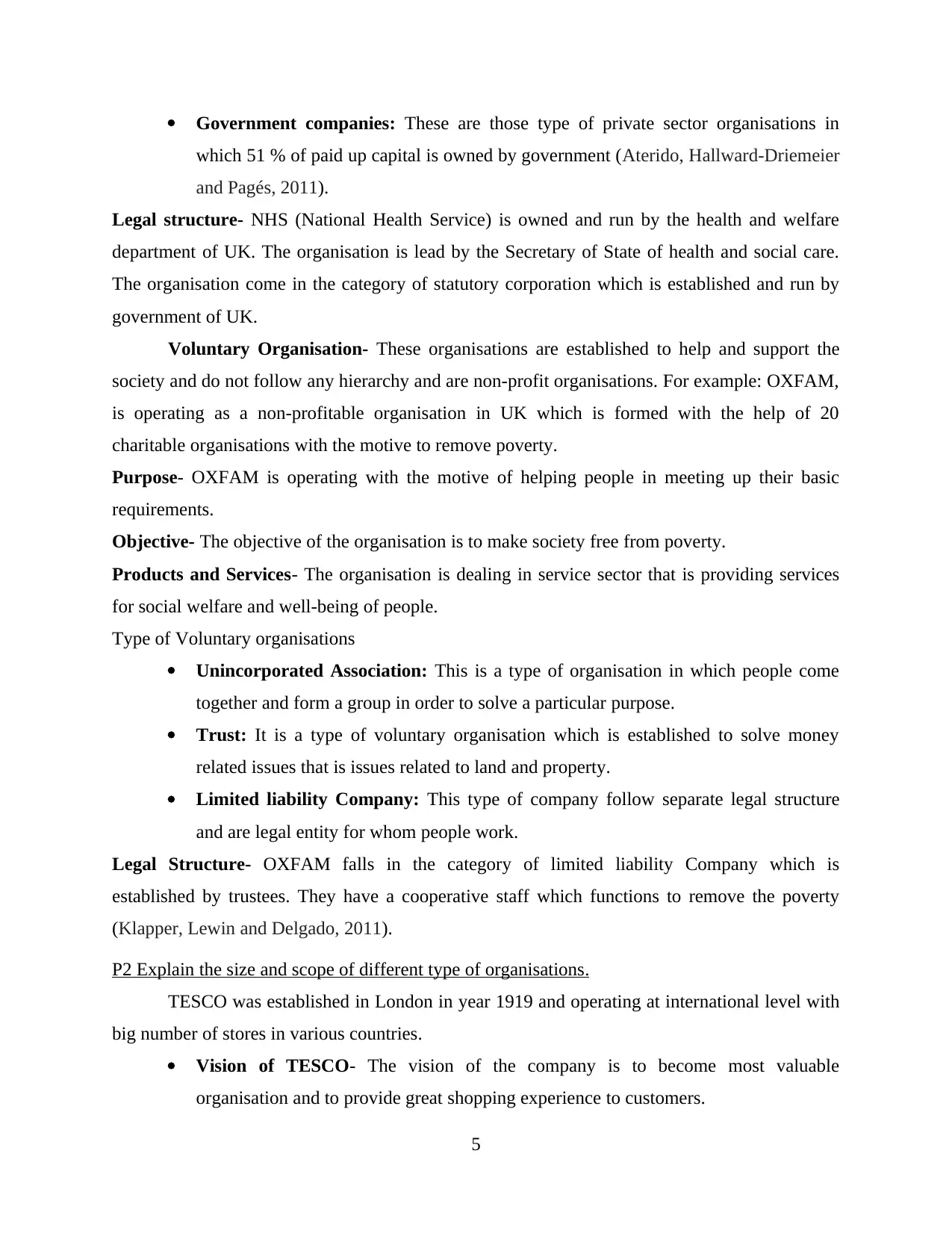
Government companies: These are those type of private sector organisations in
which 51 % of paid up capital is owned by government (Aterido, Hallward-Driemeier
and Pagés, 2011).
Legal structure- NHS (National Health Service) is owned and run by the health and welfare
department of UK. The organisation is lead by the Secretary of State of health and social care.
The organisation come in the category of statutory corporation which is established and run by
government of UK.
Voluntary Organisation- These organisations are established to help and support the
society and do not follow any hierarchy and are non-profit organisations. For example: OXFAM,
is operating as a non-profitable organisation in UK which is formed with the help of 20
charitable organisations with the motive to remove poverty.
Purpose- OXFAM is operating with the motive of helping people in meeting up their basic
requirements.
Objective- The objective of the organisation is to make society free from poverty.
Products and Services- The organisation is dealing in service sector that is providing services
for social welfare and well-being of people.
Type of Voluntary organisations
Unincorporated Association: This is a type of organisation in which people come
together and form a group in order to solve a particular purpose.
Trust: It is a type of voluntary organisation which is established to solve money
related issues that is issues related to land and property.
Limited liability Company: This type of company follow separate legal structure
and are legal entity for whom people work.
Legal Structure- OXFAM falls in the category of limited liability Company which is
established by trustees. They have a cooperative staff which functions to remove the poverty
(Klapper, Lewin and Delgado, 2011).
P2 Explain the size and scope of different type of organisations.
TESCO was established in London in year 1919 and operating at international level with
big number of stores in various countries.
Vision of TESCO- The vision of the company is to become most valuable
organisation and to provide great shopping experience to customers.
5
which 51 % of paid up capital is owned by government (Aterido, Hallward-Driemeier
and Pagés, 2011).
Legal structure- NHS (National Health Service) is owned and run by the health and welfare
department of UK. The organisation is lead by the Secretary of State of health and social care.
The organisation come in the category of statutory corporation which is established and run by
government of UK.
Voluntary Organisation- These organisations are established to help and support the
society and do not follow any hierarchy and are non-profit organisations. For example: OXFAM,
is operating as a non-profitable organisation in UK which is formed with the help of 20
charitable organisations with the motive to remove poverty.
Purpose- OXFAM is operating with the motive of helping people in meeting up their basic
requirements.
Objective- The objective of the organisation is to make society free from poverty.
Products and Services- The organisation is dealing in service sector that is providing services
for social welfare and well-being of people.
Type of Voluntary organisations
Unincorporated Association: This is a type of organisation in which people come
together and form a group in order to solve a particular purpose.
Trust: It is a type of voluntary organisation which is established to solve money
related issues that is issues related to land and property.
Limited liability Company: This type of company follow separate legal structure
and are legal entity for whom people work.
Legal Structure- OXFAM falls in the category of limited liability Company which is
established by trustees. They have a cooperative staff which functions to remove the poverty
(Klapper, Lewin and Delgado, 2011).
P2 Explain the size and scope of different type of organisations.
TESCO was established in London in year 1919 and operating at international level with
big number of stores in various countries.
Vision of TESCO- The vision of the company is to become most valuable
organisation and to provide great shopping experience to customers.
5
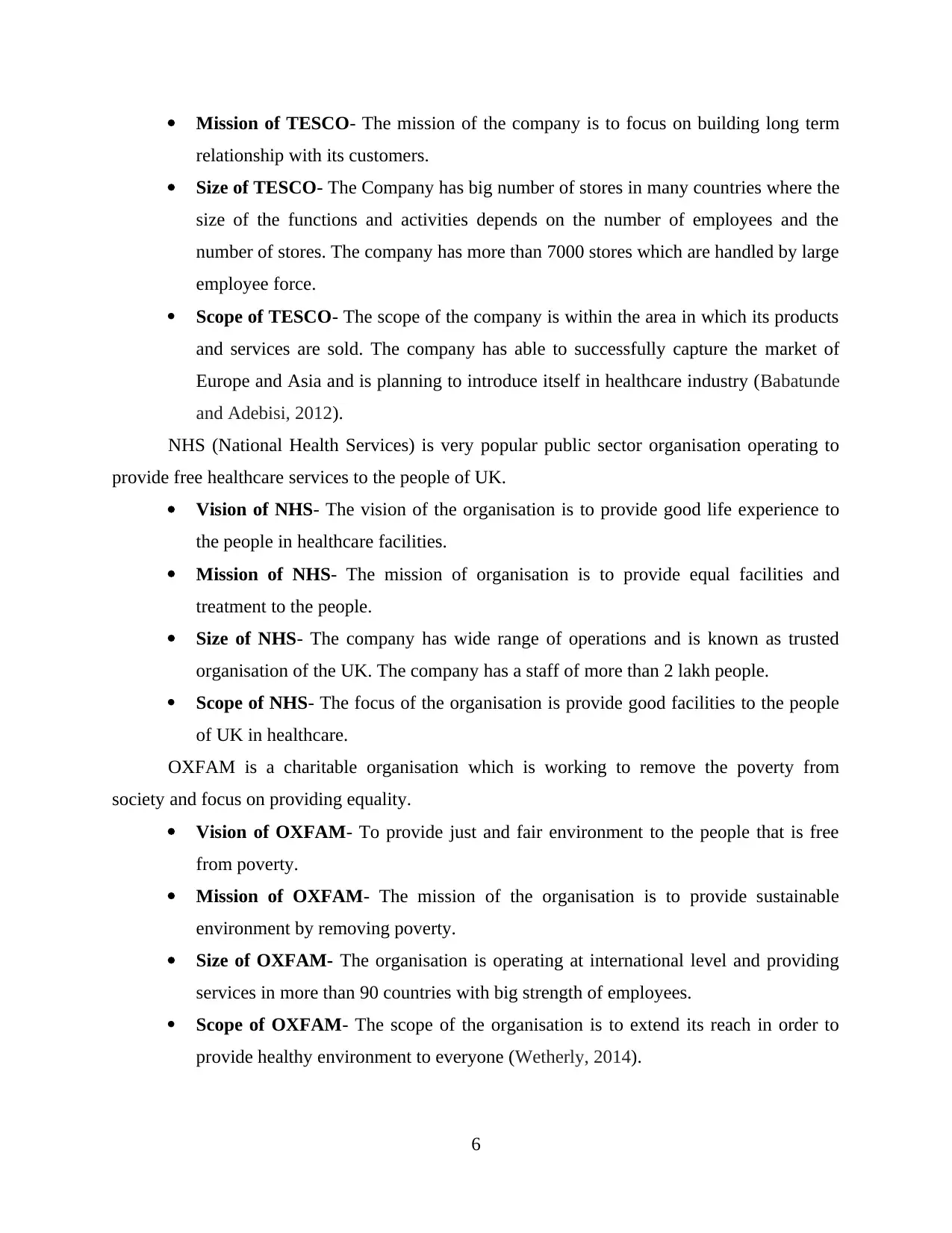
Mission of TESCO- The mission of the company is to focus on building long term
relationship with its customers.
Size of TESCO- The Company has big number of stores in many countries where the
size of the functions and activities depends on the number of employees and the
number of stores. The company has more than 7000 stores which are handled by large
employee force.
Scope of TESCO- The scope of the company is within the area in which its products
and services are sold. The company has able to successfully capture the market of
Europe and Asia and is planning to introduce itself in healthcare industry (Babatunde
and Adebisi, 2012).
NHS (National Health Services) is very popular public sector organisation operating to
provide free healthcare services to the people of UK.
Vision of NHS- The vision of the organisation is to provide good life experience to
the people in healthcare facilities.
Mission of NHS- The mission of organisation is to provide equal facilities and
treatment to the people.
Size of NHS- The company has wide range of operations and is known as trusted
organisation of the UK. The company has a staff of more than 2 lakh people.
Scope of NHS- The focus of the organisation is provide good facilities to the people
of UK in healthcare.
OXFAM is a charitable organisation which is working to remove the poverty from
society and focus on providing equality.
Vision of OXFAM- To provide just and fair environment to the people that is free
from poverty.
Mission of OXFAM- The mission of the organisation is to provide sustainable
environment by removing poverty.
Size of OXFAM- The organisation is operating at international level and providing
services in more than 90 countries with big strength of employees.
Scope of OXFAM- The scope of the organisation is to extend its reach in order to
provide healthy environment to everyone (Wetherly, 2014).
6
relationship with its customers.
Size of TESCO- The Company has big number of stores in many countries where the
size of the functions and activities depends on the number of employees and the
number of stores. The company has more than 7000 stores which are handled by large
employee force.
Scope of TESCO- The scope of the company is within the area in which its products
and services are sold. The company has able to successfully capture the market of
Europe and Asia and is planning to introduce itself in healthcare industry (Babatunde
and Adebisi, 2012).
NHS (National Health Services) is very popular public sector organisation operating to
provide free healthcare services to the people of UK.
Vision of NHS- The vision of the organisation is to provide good life experience to
the people in healthcare facilities.
Mission of NHS- The mission of organisation is to provide equal facilities and
treatment to the people.
Size of NHS- The company has wide range of operations and is known as trusted
organisation of the UK. The company has a staff of more than 2 lakh people.
Scope of NHS- The focus of the organisation is provide good facilities to the people
of UK in healthcare.
OXFAM is a charitable organisation which is working to remove the poverty from
society and focus on providing equality.
Vision of OXFAM- To provide just and fair environment to the people that is free
from poverty.
Mission of OXFAM- The mission of the organisation is to provide sustainable
environment by removing poverty.
Size of OXFAM- The organisation is operating at international level and providing
services in more than 90 countries with big strength of employees.
Scope of OXFAM- The scope of the organisation is to extend its reach in order to
provide healthy environment to everyone (Wetherly, 2014).
6
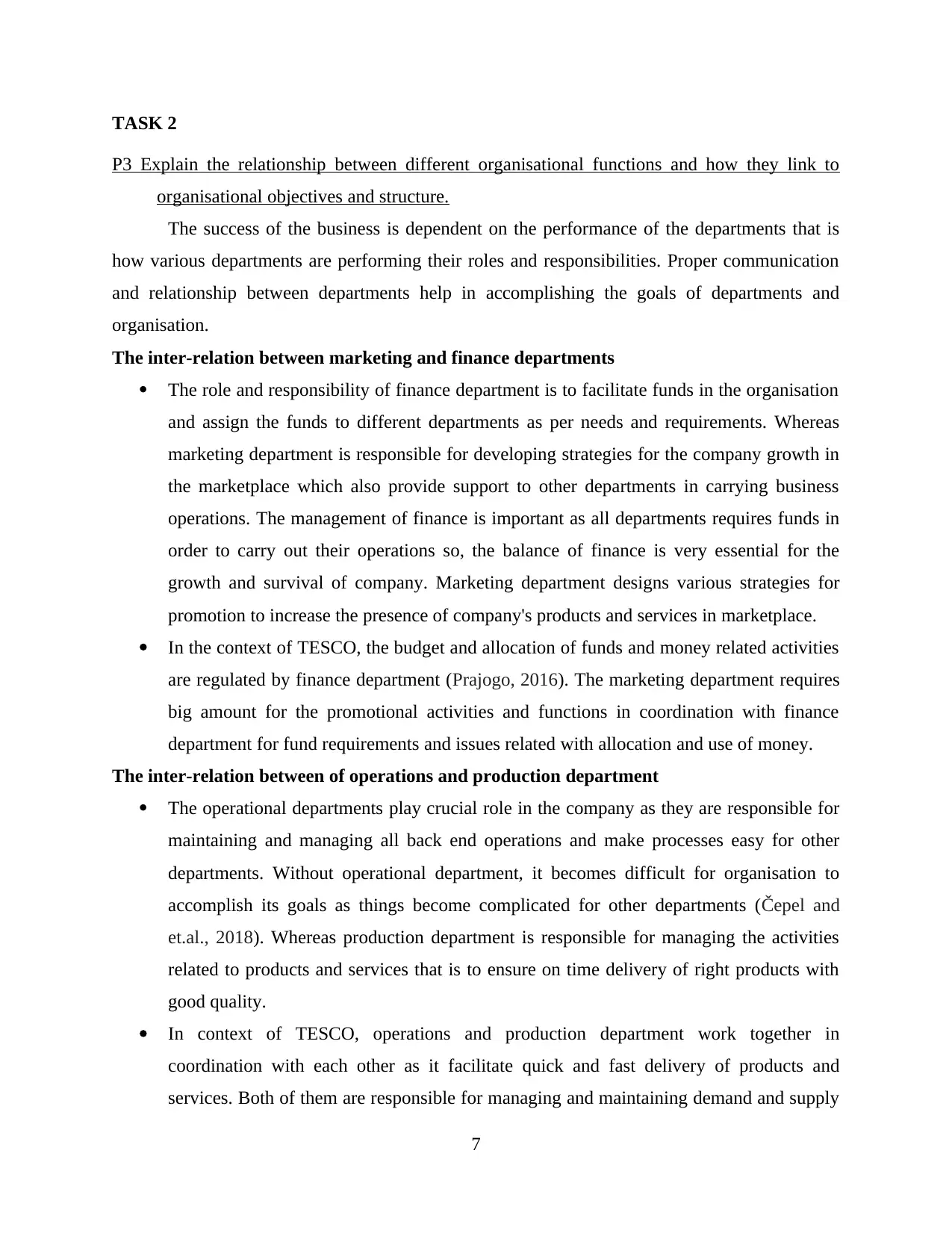
TASK 2
P3 Explain the relationship between different organisational functions and how they link to
organisational objectives and structure.
The success of the business is dependent on the performance of the departments that is
how various departments are performing their roles and responsibilities. Proper communication
and relationship between departments help in accomplishing the goals of departments and
organisation.
The inter-relation between marketing and finance departments
The role and responsibility of finance department is to facilitate funds in the organisation
and assign the funds to different departments as per needs and requirements. Whereas
marketing department is responsible for developing strategies for the company growth in
the marketplace which also provide support to other departments in carrying business
operations. The management of finance is important as all departments requires funds in
order to carry out their operations so, the balance of finance is very essential for the
growth and survival of company. Marketing department designs various strategies for
promotion to increase the presence of company's products and services in marketplace.
In the context of TESCO, the budget and allocation of funds and money related activities
are regulated by finance department (Prajogo, 2016). The marketing department requires
big amount for the promotional activities and functions in coordination with finance
department for fund requirements and issues related with allocation and use of money.
The inter-relation between of operations and production department
The operational departments play crucial role in the company as they are responsible for
maintaining and managing all back end operations and make processes easy for other
departments. Without operational department, it becomes difficult for organisation to
accomplish its goals as things become complicated for other departments (Čepel and
et.al., 2018). Whereas production department is responsible for managing the activities
related to products and services that is to ensure on time delivery of right products with
good quality.
In context of TESCO, operations and production department work together in
coordination with each other as it facilitate quick and fast delivery of products and
services. Both of them are responsible for managing and maintaining demand and supply
7
P3 Explain the relationship between different organisational functions and how they link to
organisational objectives and structure.
The success of the business is dependent on the performance of the departments that is
how various departments are performing their roles and responsibilities. Proper communication
and relationship between departments help in accomplishing the goals of departments and
organisation.
The inter-relation between marketing and finance departments
The role and responsibility of finance department is to facilitate funds in the organisation
and assign the funds to different departments as per needs and requirements. Whereas
marketing department is responsible for developing strategies for the company growth in
the marketplace which also provide support to other departments in carrying business
operations. The management of finance is important as all departments requires funds in
order to carry out their operations so, the balance of finance is very essential for the
growth and survival of company. Marketing department designs various strategies for
promotion to increase the presence of company's products and services in marketplace.
In the context of TESCO, the budget and allocation of funds and money related activities
are regulated by finance department (Prajogo, 2016). The marketing department requires
big amount for the promotional activities and functions in coordination with finance
department for fund requirements and issues related with allocation and use of money.
The inter-relation between of operations and production department
The operational departments play crucial role in the company as they are responsible for
maintaining and managing all back end operations and make processes easy for other
departments. Without operational department, it becomes difficult for organisation to
accomplish its goals as things become complicated for other departments (Čepel and
et.al., 2018). Whereas production department is responsible for managing the activities
related to products and services that is to ensure on time delivery of right products with
good quality.
In context of TESCO, operations and production department work together in
coordination with each other as it facilitate quick and fast delivery of products and
services. Both of them are responsible for managing and maintaining demand and supply
7
Paraphrase This Document
Need a fresh take? Get an instant paraphrase of this document with our AI Paraphraser
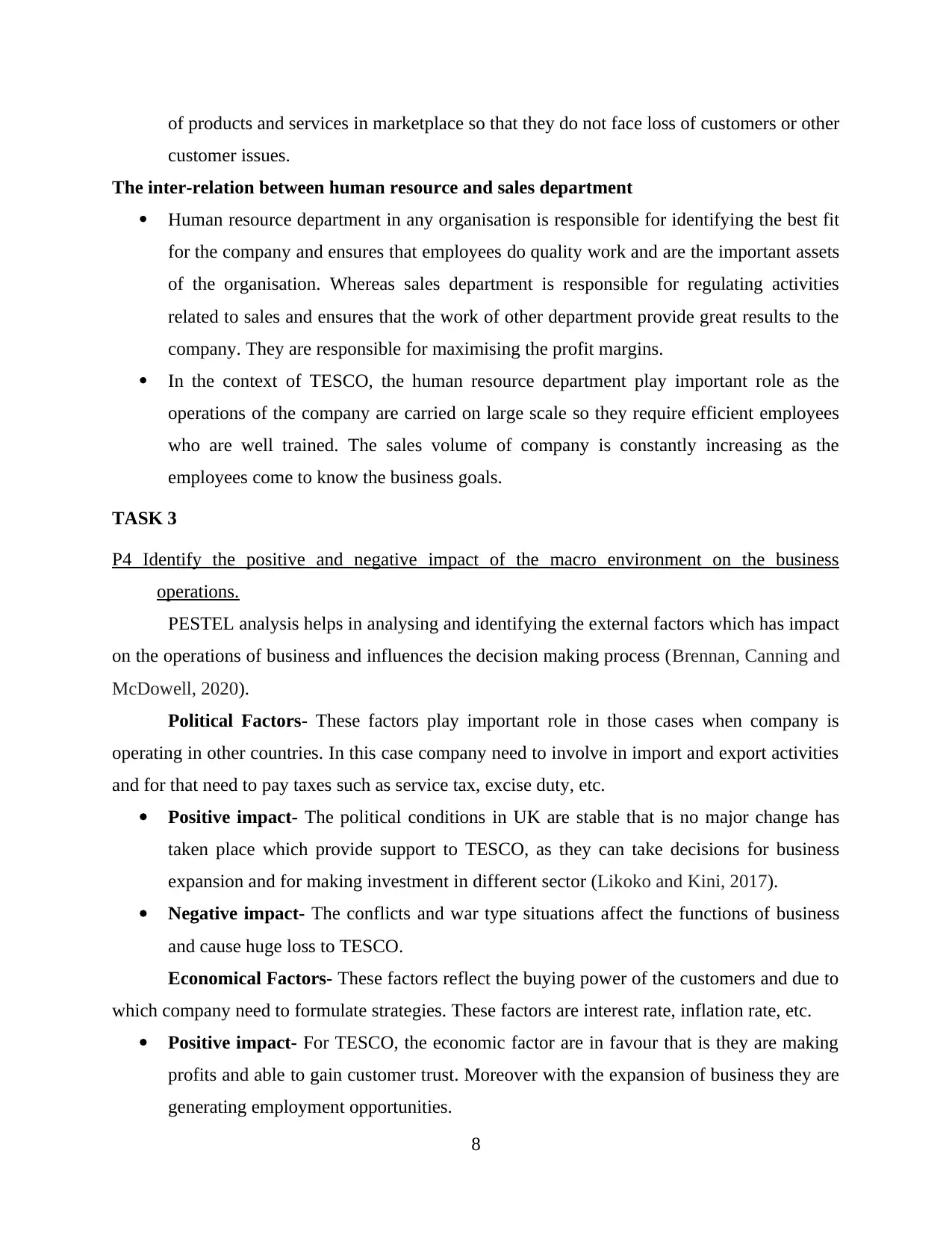
of products and services in marketplace so that they do not face loss of customers or other
customer issues.
The inter-relation between human resource and sales department
Human resource department in any organisation is responsible for identifying the best fit
for the company and ensures that employees do quality work and are the important assets
of the organisation. Whereas sales department is responsible for regulating activities
related to sales and ensures that the work of other department provide great results to the
company. They are responsible for maximising the profit margins.
In the context of TESCO, the human resource department play important role as the
operations of the company are carried on large scale so they require efficient employees
who are well trained. The sales volume of company is constantly increasing as the
employees come to know the business goals.
TASK 3
P4 Identify the positive and negative impact of the macro environment on the business
operations.
PESTEL analysis helps in analysing and identifying the external factors which has impact
on the operations of business and influences the decision making process (Brennan, Canning and
McDowell, 2020).
Political Factors- These factors play important role in those cases when company is
operating in other countries. In this case company need to involve in import and export activities
and for that need to pay taxes such as service tax, excise duty, etc.
Positive impact- The political conditions in UK are stable that is no major change has
taken place which provide support to TESCO, as they can take decisions for business
expansion and for making investment in different sector (Likoko and Kini, 2017).
Negative impact- The conflicts and war type situations affect the functions of business
and cause huge loss to TESCO.
Economical Factors- These factors reflect the buying power of the customers and due to
which company need to formulate strategies. These factors are interest rate, inflation rate, etc.
Positive impact- For TESCO, the economic factor are in favour that is they are making
profits and able to gain customer trust. Moreover with the expansion of business they are
generating employment opportunities.
8
customer issues.
The inter-relation between human resource and sales department
Human resource department in any organisation is responsible for identifying the best fit
for the company and ensures that employees do quality work and are the important assets
of the organisation. Whereas sales department is responsible for regulating activities
related to sales and ensures that the work of other department provide great results to the
company. They are responsible for maximising the profit margins.
In the context of TESCO, the human resource department play important role as the
operations of the company are carried on large scale so they require efficient employees
who are well trained. The sales volume of company is constantly increasing as the
employees come to know the business goals.
TASK 3
P4 Identify the positive and negative impact of the macro environment on the business
operations.
PESTEL analysis helps in analysing and identifying the external factors which has impact
on the operations of business and influences the decision making process (Brennan, Canning and
McDowell, 2020).
Political Factors- These factors play important role in those cases when company is
operating in other countries. In this case company need to involve in import and export activities
and for that need to pay taxes such as service tax, excise duty, etc.
Positive impact- The political conditions in UK are stable that is no major change has
taken place which provide support to TESCO, as they can take decisions for business
expansion and for making investment in different sector (Likoko and Kini, 2017).
Negative impact- The conflicts and war type situations affect the functions of business
and cause huge loss to TESCO.
Economical Factors- These factors reflect the buying power of the customers and due to
which company need to formulate strategies. These factors are interest rate, inflation rate, etc.
Positive impact- For TESCO, the economic factor are in favour that is they are making
profits and able to gain customer trust. Moreover with the expansion of business they are
generating employment opportunities.
8
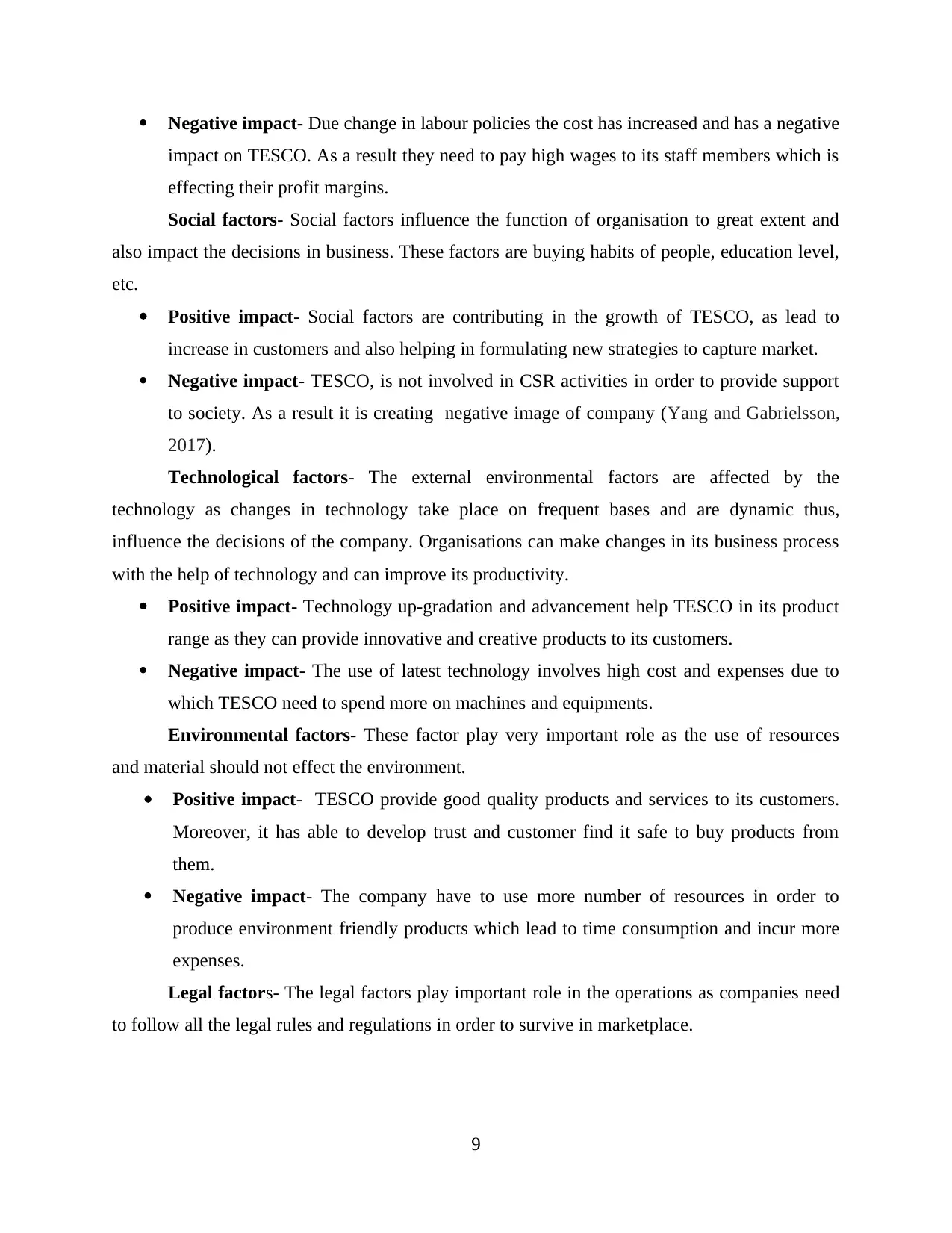
Negative impact- Due change in labour policies the cost has increased and has a negative
impact on TESCO. As a result they need to pay high wages to its staff members which is
effecting their profit margins.
Social factors- Social factors influence the function of organisation to great extent and
also impact the decisions in business. These factors are buying habits of people, education level,
etc.
Positive impact- Social factors are contributing in the growth of TESCO, as lead to
increase in customers and also helping in formulating new strategies to capture market.
Negative impact- TESCO, is not involved in CSR activities in order to provide support
to society. As a result it is creating negative image of company (Yang and Gabrielsson,
2017).
Technological factors- The external environmental factors are affected by the
technology as changes in technology take place on frequent bases and are dynamic thus,
influence the decisions of the company. Organisations can make changes in its business process
with the help of technology and can improve its productivity.
Positive impact- Technology up-gradation and advancement help TESCO in its product
range as they can provide innovative and creative products to its customers.
Negative impact- The use of latest technology involves high cost and expenses due to
which TESCO need to spend more on machines and equipments.
Environmental factors- These factor play very important role as the use of resources
and material should not effect the environment.
Positive impact- TESCO provide good quality products and services to its customers.
Moreover, it has able to develop trust and customer find it safe to buy products from
them.
Negative impact- The company have to use more number of resources in order to
produce environment friendly products which lead to time consumption and incur more
expenses.
Legal factors- The legal factors play important role in the operations as companies need
to follow all the legal rules and regulations in order to survive in marketplace.
9
impact on TESCO. As a result they need to pay high wages to its staff members which is
effecting their profit margins.
Social factors- Social factors influence the function of organisation to great extent and
also impact the decisions in business. These factors are buying habits of people, education level,
etc.
Positive impact- Social factors are contributing in the growth of TESCO, as lead to
increase in customers and also helping in formulating new strategies to capture market.
Negative impact- TESCO, is not involved in CSR activities in order to provide support
to society. As a result it is creating negative image of company (Yang and Gabrielsson,
2017).
Technological factors- The external environmental factors are affected by the
technology as changes in technology take place on frequent bases and are dynamic thus,
influence the decisions of the company. Organisations can make changes in its business process
with the help of technology and can improve its productivity.
Positive impact- Technology up-gradation and advancement help TESCO in its product
range as they can provide innovative and creative products to its customers.
Negative impact- The use of latest technology involves high cost and expenses due to
which TESCO need to spend more on machines and equipments.
Environmental factors- These factor play very important role as the use of resources
and material should not effect the environment.
Positive impact- TESCO provide good quality products and services to its customers.
Moreover, it has able to develop trust and customer find it safe to buy products from
them.
Negative impact- The company have to use more number of resources in order to
produce environment friendly products which lead to time consumption and incur more
expenses.
Legal factors- The legal factors play important role in the operations as companies need
to follow all the legal rules and regulations in order to survive in marketplace.
9
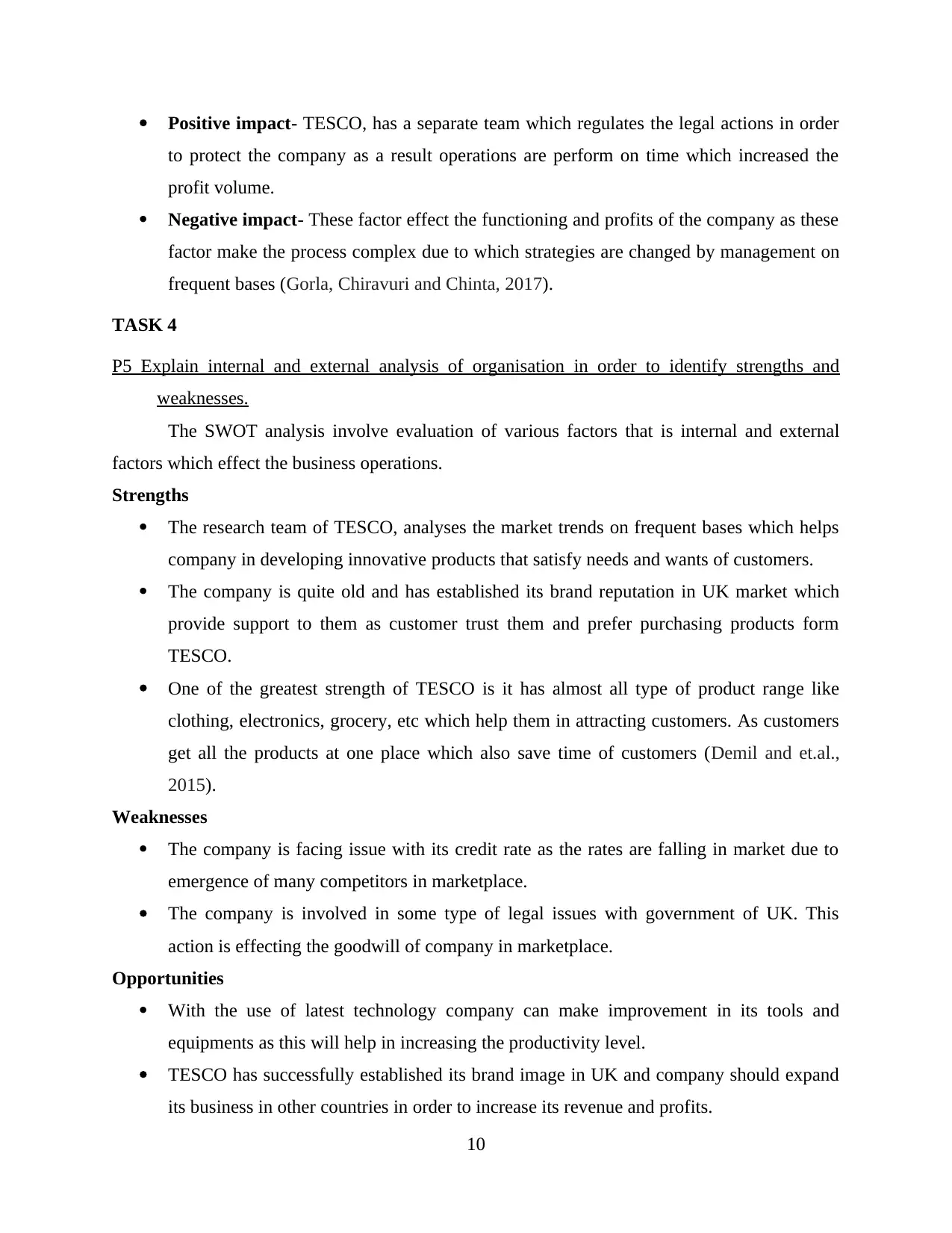
Positive impact- TESCO, has a separate team which regulates the legal actions in order
to protect the company as a result operations are perform on time which increased the
profit volume.
Negative impact- These factor effect the functioning and profits of the company as these
factor make the process complex due to which strategies are changed by management on
frequent bases (Gorla, Chiravuri and Chinta, 2017).
TASK 4
P5 Explain internal and external analysis of organisation in order to identify strengths and
weaknesses.
The SWOT analysis involve evaluation of various factors that is internal and external
factors which effect the business operations.
Strengths
The research team of TESCO, analyses the market trends on frequent bases which helps
company in developing innovative products that satisfy needs and wants of customers.
The company is quite old and has established its brand reputation in UK market which
provide support to them as customer trust them and prefer purchasing products form
TESCO.
One of the greatest strength of TESCO is it has almost all type of product range like
clothing, electronics, grocery, etc which help them in attracting customers. As customers
get all the products at one place which also save time of customers (Demil and et.al.,
2015).
Weaknesses
The company is facing issue with its credit rate as the rates are falling in market due to
emergence of many competitors in marketplace.
The company is involved in some type of legal issues with government of UK. This
action is effecting the goodwill of company in marketplace.
Opportunities
With the use of latest technology company can make improvement in its tools and
equipments as this will help in increasing the productivity level.
TESCO has successfully established its brand image in UK and company should expand
its business in other countries in order to increase its revenue and profits.
10
to protect the company as a result operations are perform on time which increased the
profit volume.
Negative impact- These factor effect the functioning and profits of the company as these
factor make the process complex due to which strategies are changed by management on
frequent bases (Gorla, Chiravuri and Chinta, 2017).
TASK 4
P5 Explain internal and external analysis of organisation in order to identify strengths and
weaknesses.
The SWOT analysis involve evaluation of various factors that is internal and external
factors which effect the business operations.
Strengths
The research team of TESCO, analyses the market trends on frequent bases which helps
company in developing innovative products that satisfy needs and wants of customers.
The company is quite old and has established its brand reputation in UK market which
provide support to them as customer trust them and prefer purchasing products form
TESCO.
One of the greatest strength of TESCO is it has almost all type of product range like
clothing, electronics, grocery, etc which help them in attracting customers. As customers
get all the products at one place which also save time of customers (Demil and et.al.,
2015).
Weaknesses
The company is facing issue with its credit rate as the rates are falling in market due to
emergence of many competitors in marketplace.
The company is involved in some type of legal issues with government of UK. This
action is effecting the goodwill of company in marketplace.
Opportunities
With the use of latest technology company can make improvement in its tools and
equipments as this will help in increasing the productivity level.
TESCO has successfully established its brand image in UK and company should expand
its business in other countries in order to increase its revenue and profits.
10
Secure Best Marks with AI Grader
Need help grading? Try our AI Grader for instant feedback on your assignments.
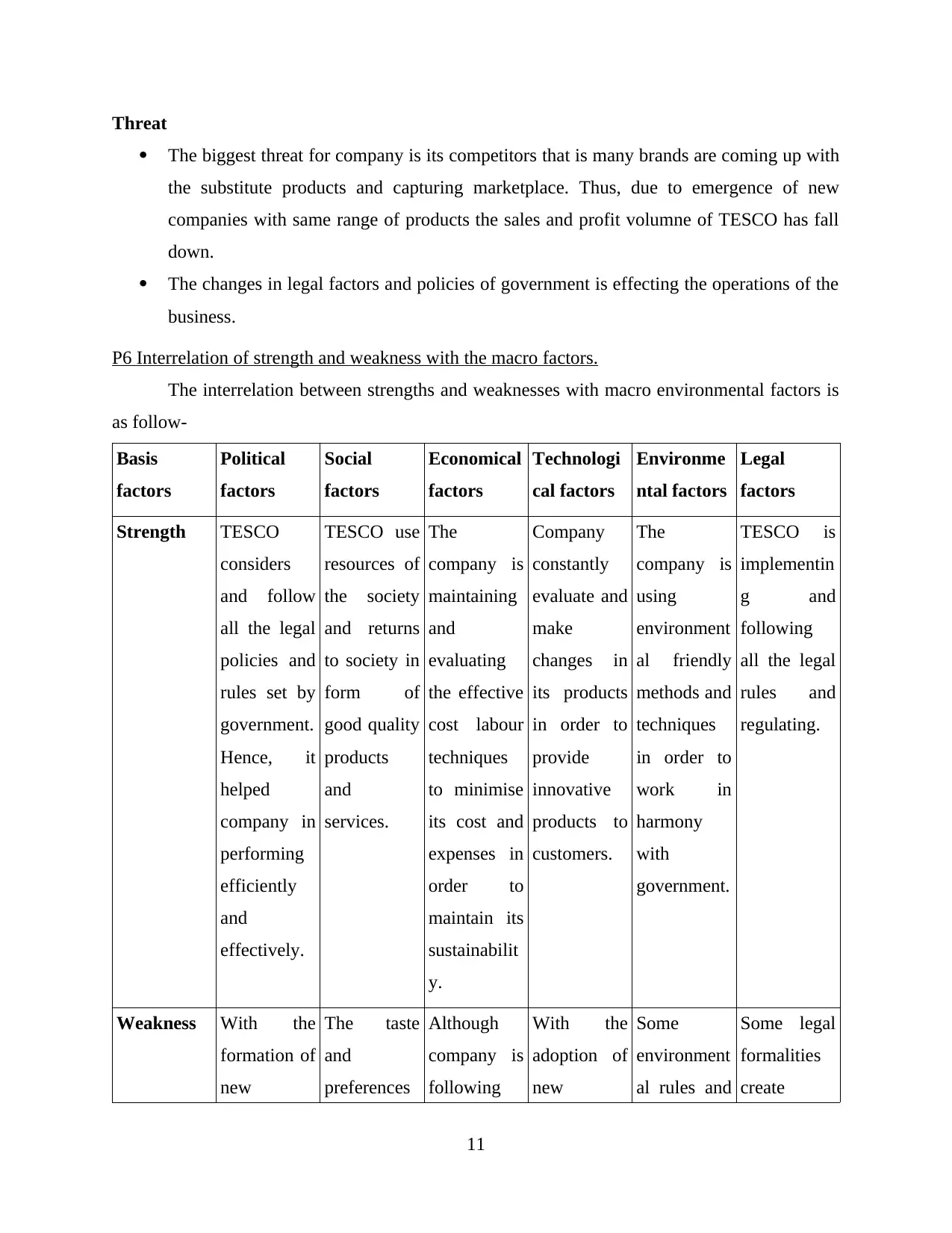
Threat
The biggest threat for company is its competitors that is many brands are coming up with
the substitute products and capturing marketplace. Thus, due to emergence of new
companies with same range of products the sales and profit volumne of TESCO has fall
down.
The changes in legal factors and policies of government is effecting the operations of the
business.
P6 Interrelation of strength and weakness with the macro factors.
The interrelation between strengths and weaknesses with macro environmental factors is
as follow-
Basis
factors
Political
factors
Social
factors
Economical
factors
Technologi
cal factors
Environme
ntal factors
Legal
factors
Strength TESCO
considers
and follow
all the legal
policies and
rules set by
government.
Hence, it
helped
company in
performing
efficiently
and
effectively.
TESCO use
resources of
the society
and returns
to society in
form of
good quality
products
and
services.
The
company is
maintaining
and
evaluating
the effective
cost labour
techniques
to minimise
its cost and
expenses in
order to
maintain its
sustainabilit
y.
Company
constantly
evaluate and
make
changes in
its products
in order to
provide
innovative
products to
customers.
The
company is
using
environment
al friendly
methods and
techniques
in order to
work in
harmony
with
government.
TESCO is
implementin
g and
following
all the legal
rules and
regulating.
Weakness With the
formation of
new
The taste
and
preferences
Although
company is
following
With the
adoption of
new
Some
environment
al rules and
Some legal
formalities
create
11
The biggest threat for company is its competitors that is many brands are coming up with
the substitute products and capturing marketplace. Thus, due to emergence of new
companies with same range of products the sales and profit volumne of TESCO has fall
down.
The changes in legal factors and policies of government is effecting the operations of the
business.
P6 Interrelation of strength and weakness with the macro factors.
The interrelation between strengths and weaknesses with macro environmental factors is
as follow-
Basis
factors
Political
factors
Social
factors
Economical
factors
Technologi
cal factors
Environme
ntal factors
Legal
factors
Strength TESCO
considers
and follow
all the legal
policies and
rules set by
government.
Hence, it
helped
company in
performing
efficiently
and
effectively.
TESCO use
resources of
the society
and returns
to society in
form of
good quality
products
and
services.
The
company is
maintaining
and
evaluating
the effective
cost labour
techniques
to minimise
its cost and
expenses in
order to
maintain its
sustainabilit
y.
Company
constantly
evaluate and
make
changes in
its products
in order to
provide
innovative
products to
customers.
The
company is
using
environment
al friendly
methods and
techniques
in order to
work in
harmony
with
government.
TESCO is
implementin
g and
following
all the legal
rules and
regulating.
Weakness With the
formation of
new
The taste
and
preferences
Although
company is
following
With the
adoption of
new
Some
environment
al rules and
Some legal
formalities
create
11
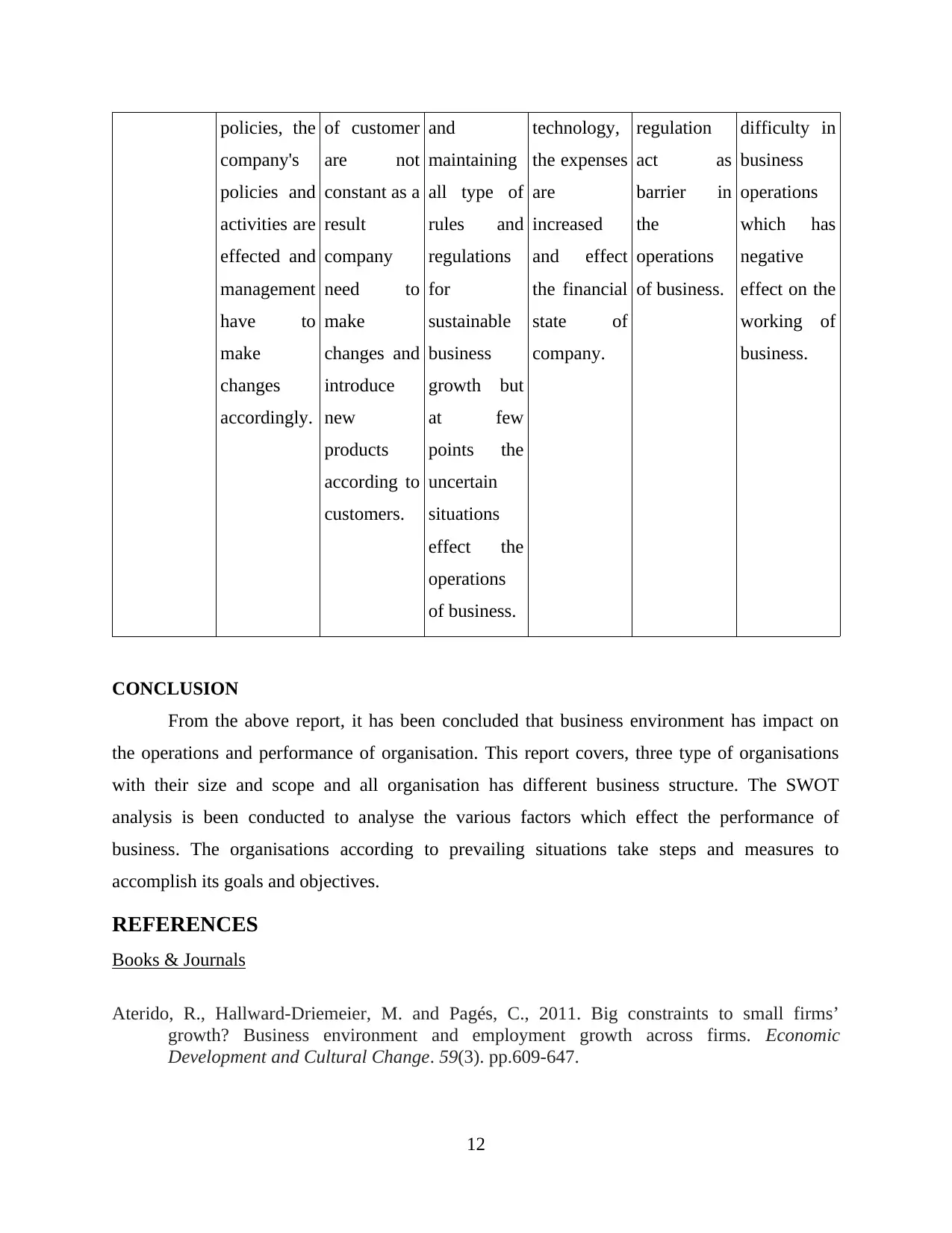
policies, the
company's
policies and
activities are
effected and
management
have to
make
changes
accordingly.
of customer
are not
constant as a
result
company
need to
make
changes and
introduce
new
products
according to
customers.
and
maintaining
all type of
rules and
regulations
for
sustainable
business
growth but
at few
points the
uncertain
situations
effect the
operations
of business.
technology,
the expenses
are
increased
and effect
the financial
state of
company.
regulation
act as
barrier in
the
operations
of business.
difficulty in
business
operations
which has
negative
effect on the
working of
business.
CONCLUSION
From the above report, it has been concluded that business environment has impact on
the operations and performance of organisation. This report covers, three type of organisations
with their size and scope and all organisation has different business structure. The SWOT
analysis is been conducted to analyse the various factors which effect the performance of
business. The organisations according to prevailing situations take steps and measures to
accomplish its goals and objectives.
REFERENCES
Books & Journals
Aterido, R., Hallward-Driemeier, M. and Pagés, C., 2011. Big constraints to small firms’
growth? Business environment and employment growth across firms. Economic
Development and Cultural Change. 59(3). pp.609-647.
12
company's
policies and
activities are
effected and
management
have to
make
changes
accordingly.
of customer
are not
constant as a
result
company
need to
make
changes and
introduce
new
products
according to
customers.
and
maintaining
all type of
rules and
regulations
for
sustainable
business
growth but
at few
points the
uncertain
situations
effect the
operations
of business.
technology,
the expenses
are
increased
and effect
the financial
state of
company.
regulation
act as
barrier in
the
operations
of business.
difficulty in
business
operations
which has
negative
effect on the
working of
business.
CONCLUSION
From the above report, it has been concluded that business environment has impact on
the operations and performance of organisation. This report covers, three type of organisations
with their size and scope and all organisation has different business structure. The SWOT
analysis is been conducted to analyse the various factors which effect the performance of
business. The organisations according to prevailing situations take steps and measures to
accomplish its goals and objectives.
REFERENCES
Books & Journals
Aterido, R., Hallward-Driemeier, M. and Pagés, C., 2011. Big constraints to small firms’
growth? Business environment and employment growth across firms. Economic
Development and Cultural Change. 59(3). pp.609-647.
12
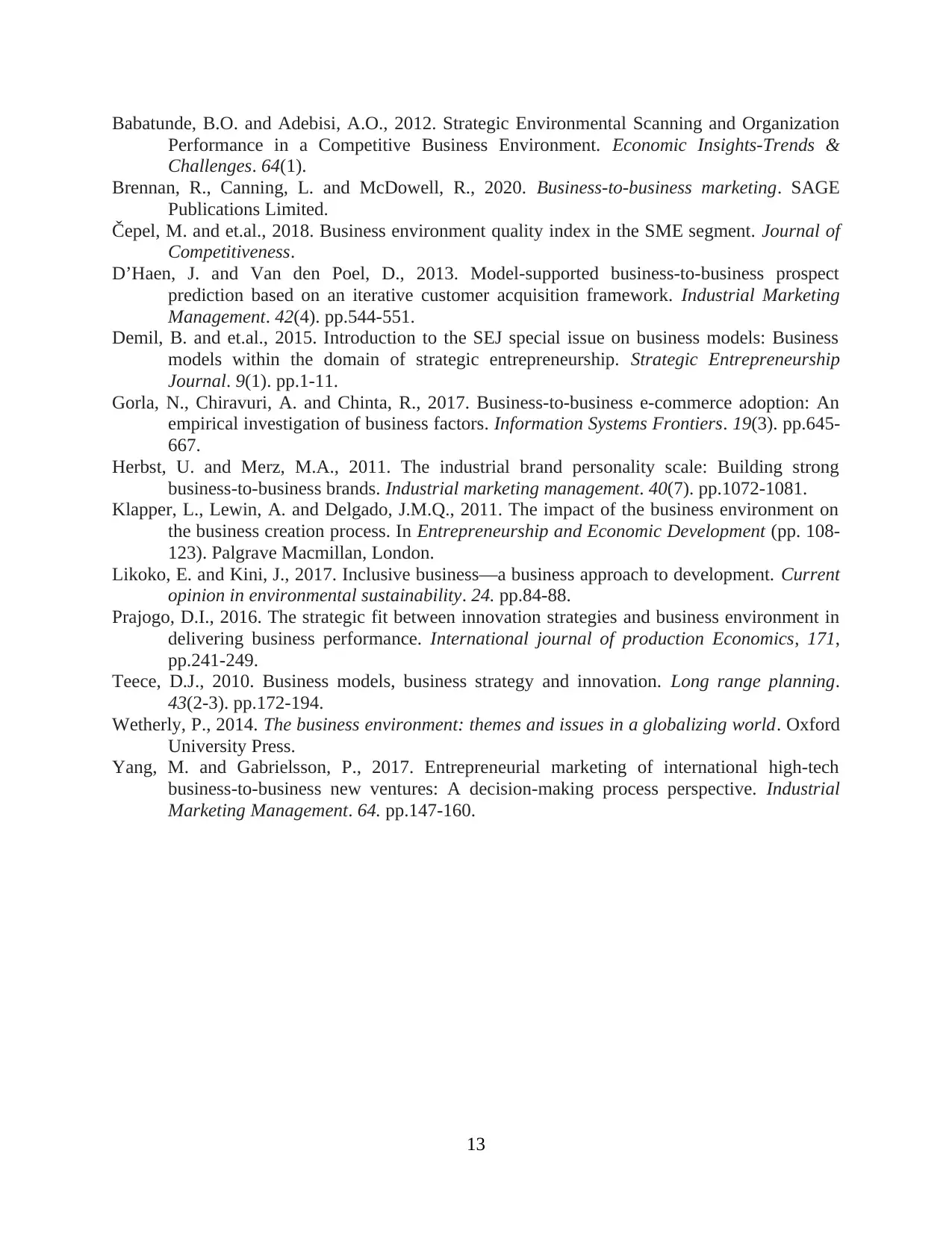
Babatunde, B.O. and Adebisi, A.O., 2012. Strategic Environmental Scanning and Organization
Performance in a Competitive Business Environment. Economic Insights-Trends &
Challenges. 64(1).
Brennan, R., Canning, L. and McDowell, R., 2020. Business-to-business marketing. SAGE
Publications Limited.
Čepel, M. and et.al., 2018. Business environment quality index in the SME segment. Journal of
Competitiveness.
D’Haen, J. and Van den Poel, D., 2013. Model-supported business-to-business prospect
prediction based on an iterative customer acquisition framework. Industrial Marketing
Management. 42(4). pp.544-551.
Demil, B. and et.al., 2015. Introduction to the SEJ special issue on business models: Business
models within the domain of strategic entrepreneurship. Strategic Entrepreneurship
Journal. 9(1). pp.1-11.
Gorla, N., Chiravuri, A. and Chinta, R., 2017. Business-to-business e-commerce adoption: An
empirical investigation of business factors. Information Systems Frontiers. 19(3). pp.645-
667.
Herbst, U. and Merz, M.A., 2011. The industrial brand personality scale: Building strong
business-to-business brands. Industrial marketing management. 40(7). pp.1072-1081.
Klapper, L., Lewin, A. and Delgado, J.M.Q., 2011. The impact of the business environment on
the business creation process. In Entrepreneurship and Economic Development (pp. 108-
123). Palgrave Macmillan, London.
Likoko, E. and Kini, J., 2017. Inclusive business—a business approach to development. Current
opinion in environmental sustainability. 24. pp.84-88.
Prajogo, D.I., 2016. The strategic fit between innovation strategies and business environment in
delivering business performance. International journal of production Economics, 171,
pp.241-249.
Teece, D.J., 2010. Business models, business strategy and innovation. Long range planning.
43(2-3). pp.172-194.
Wetherly, P., 2014. The business environment: themes and issues in a globalizing world. Oxford
University Press.
Yang, M. and Gabrielsson, P., 2017. Entrepreneurial marketing of international high-tech
business-to-business new ventures: A decision-making process perspective. Industrial
Marketing Management. 64. pp.147-160.
13
Performance in a Competitive Business Environment. Economic Insights-Trends &
Challenges. 64(1).
Brennan, R., Canning, L. and McDowell, R., 2020. Business-to-business marketing. SAGE
Publications Limited.
Čepel, M. and et.al., 2018. Business environment quality index in the SME segment. Journal of
Competitiveness.
D’Haen, J. and Van den Poel, D., 2013. Model-supported business-to-business prospect
prediction based on an iterative customer acquisition framework. Industrial Marketing
Management. 42(4). pp.544-551.
Demil, B. and et.al., 2015. Introduction to the SEJ special issue on business models: Business
models within the domain of strategic entrepreneurship. Strategic Entrepreneurship
Journal. 9(1). pp.1-11.
Gorla, N., Chiravuri, A. and Chinta, R., 2017. Business-to-business e-commerce adoption: An
empirical investigation of business factors. Information Systems Frontiers. 19(3). pp.645-
667.
Herbst, U. and Merz, M.A., 2011. The industrial brand personality scale: Building strong
business-to-business brands. Industrial marketing management. 40(7). pp.1072-1081.
Klapper, L., Lewin, A. and Delgado, J.M.Q., 2011. The impact of the business environment on
the business creation process. In Entrepreneurship and Economic Development (pp. 108-
123). Palgrave Macmillan, London.
Likoko, E. and Kini, J., 2017. Inclusive business—a business approach to development. Current
opinion in environmental sustainability. 24. pp.84-88.
Prajogo, D.I., 2016. The strategic fit between innovation strategies and business environment in
delivering business performance. International journal of production Economics, 171,
pp.241-249.
Teece, D.J., 2010. Business models, business strategy and innovation. Long range planning.
43(2-3). pp.172-194.
Wetherly, P., 2014. The business environment: themes and issues in a globalizing world. Oxford
University Press.
Yang, M. and Gabrielsson, P., 2017. Entrepreneurial marketing of international high-tech
business-to-business new ventures: A decision-making process perspective. Industrial
Marketing Management. 64. pp.147-160.
13
1 out of 13
Related Documents
Your All-in-One AI-Powered Toolkit for Academic Success.
+13062052269
info@desklib.com
Available 24*7 on WhatsApp / Email
![[object Object]](/_next/static/media/star-bottom.7253800d.svg)
Unlock your academic potential
© 2024 | Zucol Services PVT LTD | All rights reserved.





